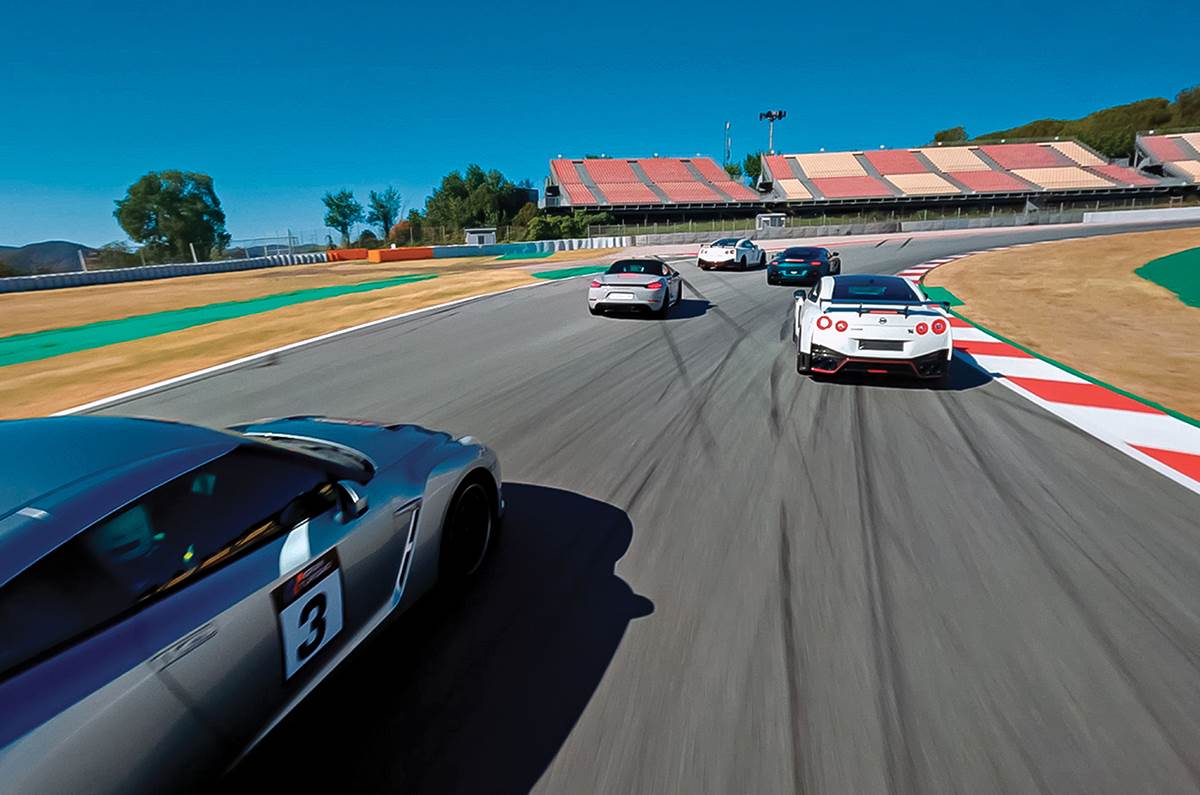Gran Turismo, the film, tries to be as true to life as the racing simulator it’s named after. We experience both, along with a breakneck track ride in a Nissan GT-R Nismo.
That I love cars should come as no surprise at this point. I am also, however, a big movie buff, but again, this isn’t surprising; who doesn’t love movies? What you might not know is that I’m also quite an avid gamer, and after a long day, I like to unwind by mashing furiously at a controller in front of my TV. So, when I heard that those three interests of mine were going to coalesce into one piece of media, I knew it was something I just couldn’t miss. Then I heard it would be based around Gran Turismo – a game I’ve been playing across its various iterations for 18 years – and that only made it better.
In 1997, Gran Turismo was a video game like no other. It brought true-to-life driving simulation, something you’d have only found inside the HQ of a car manufacturer or racing team, into millions of living rooms across the globe, via Sony’s first PlayStation console. Its focus on realism over outright entertainment was a gamble, but one that paid off, as with over 10 million copies sold, it remains the bestselling game on that console. Conceptualised and created by visionary game designer (and petrolhead turned racing driver) Kazunori Yamauchi, it went to painstaking lengths to realistically recreate the physics, not to mention ultra-realistic 3D models, of hundreds of cars, at a level unheard of in video games. A quarter century later, it is closer to life than ever, and you can even experience it in VR.
In 2008, Nissan, whose cars feature prominently in the series, started GT Academy, a programme that would put the best Gran Turismo drivers into real racing cars to compete in races around the world. The 2023 film Gran Turismo follows the life and career of one of these drivers, Jann Mardenborough, that took him from the console to the racetrack. Last month, Nissan India took me to Spain to not just attend the European premiere of
Gran Turismo, but also meet Jann and director Neill Blomkamp (of District 9 and Elysium fame) and participate in some sim-to-track action. 18-year-old Gavin would have never believed it.
To sim it up
My years playing Gran Turismo have largely been on a couch with a controller in hand, although I have occasionally dabbled with a steering wheel accessory and a bit of online competition. Five PlayStation 5s synced up to five 4K screens with a full-on Logitech G Pro racing rig for a race around Spain’s Catalunya circuit – set up in the pit lane of Spain’s Catalunya circuit? That’s new.
My competitors? A mix of international journalists and influencers here for the event, none of whose gaming or driving backgrounds I’m aware of. The cars? A selection of GR.3 racers (the game’s semi-fictionalised version of FIA’s GT3 class), including derivatives of a Ferrari 488, McLaren 650S and the film’s hero car, a Nissan GT-R Nismo. No guesses for which one I pick.
Not to brag, but I absolutely own my first session, my GT-R finishing a couple of corners before the next competitor. I try not to look smug. But then I notice one of the five racing rigs is not like the others, because it has a PSVR2 headset attached to it. I have to try it out.
The subsequent race is not so hot, as slipping on the headset changes the game almost entirely. The level of immersion is at times overwhelming, because you can’t take your eyes off the screen for relief; you’re basically in the car. I’m trying to remember every real-life track lesson I’ve ever had – look into the apex, make calculated steering inputs, trail brake whenever possible – but it’s all falling apart. Though the rig is stationary, it feels like it’s moving. Every chicane that rolls under my tyres makes my head shake. After a few offs, I do finally get used to it, but ultimately, I can only manage second place.

Racing in VR adds a new level of immersion. Can also make you nauseous.
I step off the rig sweating and a little nauseous. Not even driving a real car hard around a track has ever left me with that sensation. It’s a hugely immersive way to play, and one that will take a lot of getting used to, but hey, they never said going from gamer to racer would be easy.
Movie review
The hero’s journey
The most exciting part of the Gran Turismo movie for me happens in the opening few minutes. It shows game creator Kazunori Yamauchi and his team at a track capturing visual and performance data from cars to create the original 1997 game. Apart from thrilling my inner nerd, it also sets the tone for how a video game was deemed a worthy tool to train real racing drivers, and what convinced Nissan’s marketing team to roll the dice with the GT Academy.

We attended the European premiere of the movie in Spain.
The film follows the journey of Jann Mardenborough (Archie Madekwe), a Gran Turismo player as he is selected to join GT Academy, an initiative spearheaded by Nissan marketing exec Danny Moore (Orlando Bloom). Stranger Things’ David Harbour plays ex-racing driver Jack Salter who reluctantly signs on to train the gamers-to-racers at the academy, while Mardenborough’s parents are brought to screen by Geri Halliwell and Djimon Honsou.
The thread that ties this film together is heart, be it in the family moments, the underdog’s triumph, the overwhelming nature of sudden fame, the fear of failure or the spirit of competition. It does stray into Hollywood cliché territory from time to time, and since it’s based on a true story, you will constantly pick up on these moments. Also, for motorsport and gaming nerds, some dramatised beats will stand out – like all the action happening on the final lap. To be fair, that does ramp the tension up.

We received the full red carpet treatment at the European premiere of the Gran Turismo movie.
What absolutely sells Gran Turismo is the stunning sound design and incredible camerawork, both of which put you smack bang in the driver’s seat like few other movies have. For car enthusiasts, at least, that alone is worth the price of entry. Who knows, it might even be enough to convince them that they too can make the transition from gamer to racer.
Screen to track
We’ve only just arrived at the Catalunya circuit, and immediately, we’re prompted to shed all loose items from our person and slip into racing overalls and a helmet. Yet, I’ve been told, to some amount of disappointment, that we will not be driving anything. If that’s so, then why is there a grid full of supercars waiting on the start/finish straight?

The racing is close, frantic and chaotic – designed for entertainment over speed.
Turns out we will be riding shotgun with a troupe of racing drivers, and their job is not just to race one another, but to recreate the white-knuckle, near-miss tension of the video game for real. An Aston Martin V8 Vantage, a few Porsches, a Ferrari 488 GTB, a Lamborghini Huracan and a brace of Nismo GT-Rs. As I hop into the passenger seat of the GT-R in P1 – my first time in the 600hp Nismo version – I’m amazed at how well this 14-year-old car has aged.
During the warm-up lap itself, it’s clear this is more than your average taxi ride. Though still in grid formation, the cars are weaving about to warm their tyres, coming within inches of one another. As they cross the start line, the discipline we’re used to in motorsport is thrown out the window; intentionally. This is far more like a bunch of kids racing online, the fastest cornering lines being ignored in favour of audacious overtakes and close-quarters skirmishes. All that’s missing is the insults over the voice chat.

We rode shotgun in the 600hp Nissan GT-R Nismo.
I let out more than a few loud cheers as I’m thrown around the passenger seat by the very real g-forces in this re-enactment of a video game. This is the kind of motorsport I could get into.
Gamer to Racer

Jann Mardenborough, racing driver & GT Academy winner.
What was it like finding out you got into GT Academy?
I believe in fate and the process of me finding the Academy is a story in its own right. When I qualified to make it to Silverstone, one door opened, and the next door was winning. Of course, I just want to see how far I can go, and to this day, I am trying to open doors and see how far I can run with the flag. So, I still feel the job is not done after winning the Academy.
What about your gaming journey – was it always racing games?
It was important to me, even when I was 9 or 10 years old, that the game be as realistic as possible. Because I want to drive the real car in real life. Even at that age, I could distinguish between Gran Turismo 1 or 2 or 3. I was not really interested in arcade racers. Sim racing was not really a thing back then, but I could visually tell by the way that the physics model is in GT that some care has gone into it and that was important to me. I have two interests – racing games and first-person shooters (FPS). I have so many memories of playing Call of Duty 4 in an online lobby with the headset, and long nights just talking to friends, just really talking rubbish, and lots of good moments.
Aside from the racing and the gaming, are you a big petrolhead?
Yeah, I am a car guy! Cars were my first interest in… anything. I have so many aspirations to own certain cars. I have three nice cars, which I love, and they’re all very different. Then there’s things I want to own in the future and some I just want to try. Even here [at the Catalunya Circuit], there is one car I was interested in – the 911 T, because it has a manual. I drove it; it’s not the fastest, but it’s more fun.
Spacecraft to race car

Neill Blomkamp, Director, Gran Turismo.
Was Gran Turismo a big departure from your previous work?
Yeah, it was radically different, which is why I love it. The other films I made, which were written by me, have a very bleak view of humanity. I knew when I read this film, I wanted to make it immediately, because it was a positive message. I wanted to make something like this, and then I can go back to my dark, insane stuff.
Did your background in visual effects inform this movie?
I don’t think so. But there’s a lot of real-world stuff I’m into that did. I fly R/C helicopters and FPV drones, so I wanted to bring that into the movie. The other thing I love is cars, so there was this real-world approach to filming cars that I felt very creatively interested in.
Is it difficult to make cars look fast?
Oh, literally every single day, I would go to the stunt co-ordinator and say ‘Can we not make them go faster?’ All I cared about was maximum speed, so I totally agree with you. You have to be doing something like F1 or NASCAR, where the cars are automatically hitting 200mph, that is the baseline.
Was it a challenge working with and around the whole racing circus?
Some of the tracks were more hospitable, some were more difficult. At Le Mans, they just would not let us film. Hungaroring in Budapest was our home base and they let us take over the track for two months. I loved shooting in Dubai, I loved shooting at Red Bull Ring, the Nürburgring was incredible. But I know what you’re saying, and logistically, it’s the most difficult film I have ever made. There is a lot of logistics behind motorsports, and people don’t understand what it takes to get those cars onto tracks and film them. It’s a lot of work.


























